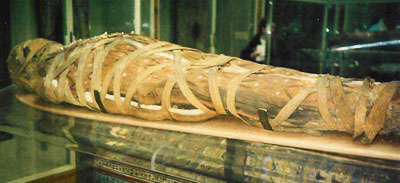Like most royal and wealthy citizens in ancient Egyptian times, King Tut was mummified – this was believed essential for the spiritual essence of the person to continue into the afterlife. Mummification was an elaborate process that took at least 70 days.
Click of the headings below to follow the process.
-
THE PREPARATION
The body was laid in a bed of natron, a combination of salt and baking soda that naturally occurs in Egypt, to dry out the flesh. This material was also stuffed
into the body cavity.
-
RESINS
Resins were then applied to soften
the leathery skin.
-
THE BRAIN
The brain was removed through the nostrils with a long metal hook.
-
THE HEART
The heart was left in place or removed, dried out, and put back into the chest cavity.
-
INNER ORGANS
The lungs, liver, stomach, and intestines were removed through an incision in the left side of the body. Each was carefully dried in salts, anointed with oils, and then wrapped. These were put into a solid gold miniature coffin which in turn was placed in a stone chest covered in protective spells.
-
FINAL STEPS
Golden cylinders covered the king's fingers and toes and a magnificent golden funerary mask protected his face.
The Mummy was complete!

Tutankhamun's mummy has never left the Valley of the Kings and remains in the tomb today, where it is protected by climate-control.
This material is adapted from text written by Dr. Zahi Hawass in his book
Tutankhamun and the Golden Age of the Pharaohs (National Geographic Books 2005).




















